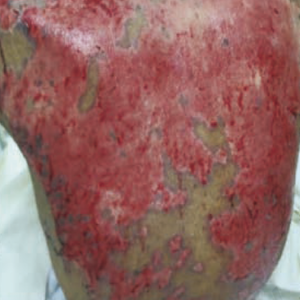Pemphigus vulgaris mimicking Steven-Johnson syndrome/toxic epidermal necrolysis: report of an unusual case

HTML: 3
All claims expressed in this article are solely those of the authors and do not necessarily represent those of their affiliated organizations, or those of the publisher, the editors and the reviewers. Any product that may be evaluated in this article or claim that may be made by its manufacturer is not guaranteed or endorsed by the publisher.
Pemphigus vulgaris (PV) is an autoimmune blistering disease affecting the skin and mucosa. It clinically presents as painful erosions, mainly in the oral cavity, and flaccid blisters and erosions on the skin. Steven-Johnson syndrome/toxic epidermal necrolysis (SJS/TEN) is a severe mucocutaneous drug hypersensitivity reaction characterized by painful, dusky, erythematous eruptions that often progress to blisters, erosions, and extensive epidermal detachment accompanied by systemic symptoms. Herein, we report the case of a 48-year-old man who presented with extensive skin and mucosal lesions following the ingestion of an unknown medication. The patient’s symptoms clinically mimicked SJS, and accordingly, a preliminary diagnosis of SJS/TEN was made. However, clinical investigation of skin biopsy and direct immunofluorescence assay results indicated PV, and a final diagnosis of PV was established.
Porro AM, Seque CA, Ferreira MCC, Enokihara MMSS. Pemphigus vulgaris. An Bras Dermatol 2019;94:264-78.
Fakoya AOJ, Omenyi P, Anthony P, et al. Stevens-Johnson syndrome and toxic epidermal necrolysis; extensive review of reports of drug-induced etiologies, and possible therapeutic modalities. Open Access Maced J Med Sci 2018;6:730-8.
McLarney RM, Valdes-Rodriguez RH, Isaza-Gonzalez G, et al. Paraneoplastic pemphigus mimicking toxic epidermal necrolysis: an underdiagnosed entity?. JAAD Case Rep 2017;4:67-71.
Hayanga AJ, Lee TM, Pannucci CJ, et al. Paraneoplastic pemphigus in a burn intensive care unit: case report and review of the literature. J Burn Care Res 2010;31:826-9.
Wang J, Zhu X, Li R, et al. Paraneoplastic pemphigus associated with Castleman tumor: a commonly reported subtype of paraneoplastic pemphigus in China. Arch Dermatol 2005;141:1285-93.
Lyon CC, Carmichael AJ. Toxic epidermal necrolysis and paraneoplastic pemphigus. Lancet 1998;352:149.
Padhiyar JK, Patel NH, Ninama K, et al. Paraneoplastic pemphigus presenting as toxic epidermal necrolysis: a case report. Nepal J Dermatol Venereol Leprol 2018;16:59-62.
Copyright (c) 2023 the Author(s)

This work is licensed under a Creative Commons Attribution-NonCommercial 4.0 International License.
PAGEPress has chosen to apply the Creative Commons Attribution NonCommercial 4.0 International License (CC BY-NC 4.0) to all manuscripts to be published.





 https://doi.org/10.4081/dr.2023.9649
https://doi.org/10.4081/dr.2023.9649



